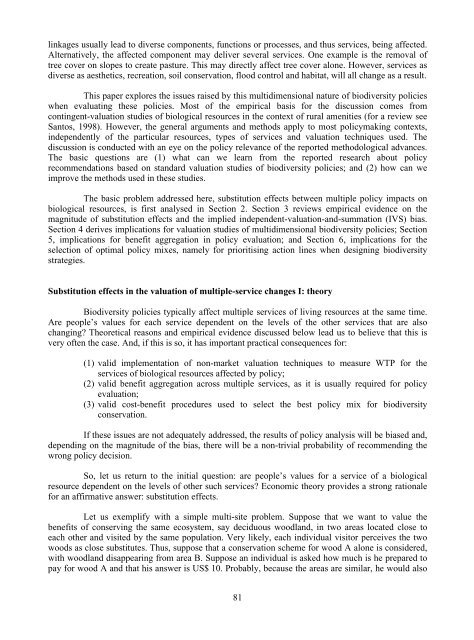The valuable services <strong>of</strong> living resources are <strong>of</strong>ten identified with components themselves.For example: (1) birds for a birdwatcher; (2) particular genes for a plant breeder who creates new,disease-resistant, varieties; or (3) different landscape elements that enhance the aesthetic experience <strong>of</strong>visitors and local dwellers. Sometimes, these services do not depend on use but only on knowing aboutthe continued existence <strong>of</strong> a living component, as it is the case with people having existence values forwhales. Very <strong>of</strong>ten, valuable services are provided not directly by components, but by functions ordynamic processes at particular levels <strong>of</strong> organisation: (1) soil protection by vegetation; (2) nutrientrecycling by bacteria in soils; or (3) the colonisation <strong>of</strong> burnt areas by seeds coming from remainingvegetation patches.Although some valuable functions and dynamic processes are enhanced by higher levels <strong>of</strong>biodiversity, this is not always the case; even when it is, the relationship may not be simple andself-evident [Odum (1971)]. So, some valuable services <strong>of</strong> biological resources are not linked tobiodiversity levels. However, in this paper, we indistinctly use the term biodiversity polices for allpolicies aimed at preserving the services <strong>of</strong> biological resources.Many public policies, particularly biodiversity polices, have an impact on living resources.They can change their components, structure, function or dynamics at different levels. Thus, they willlikely change the services provided by biological resources, and, therefore, the wellbeing <strong>of</strong> thosebenefiting from those services.How should these welfare effects <strong>of</strong> policy affect policy decisions? The economist’s answerassumes that the relevant value concept is people’s values for the affected services, that is: theamounts <strong>of</strong> other valued things (income) they are prepared to give up for these services.Accordingly, these values should directly enter as an input into any policy decision implyingthese trade-<strong>of</strong>fs <strong>of</strong> economic income for the services <strong>of</strong> biological resources. Examples <strong>of</strong> thesedecisions are: (1) deciding whether to go ahead with a biodiversity scheme (by weighing conservationbenefits against the corresponding social cost); (2) selecting the best biodiversity policy mix (onsocial-welfare grounds); and (3) prioritising lines <strong>of</strong> action for a biodiversity strategy when, as always,policy funds are scarce.Determining how the services <strong>of</strong> biological resources are affected by policy is a task forbiologists, landscape ecologists and other scientists. The applied economist’s task is to measure howpeople’s wellbeing is affected by these changes in service levels, by measuring people’swillingness-to-pay (WTP) for either avoiding degradation or getting improvements in service levels.As there are no markets for many services <strong>of</strong> living resources, WTP cannot be directlyinferred from market demands for these services. Hence, it has to be measured with non-marketvaluation techniques. These are based on either:1. value-eliciting surveys (that is: stated-preference techniques, including contingentvaluation, contingent ranking and choice experiments); or2. value-traces implicit in observed behaviour and revealed by modelling this behaviour(that is: revealed-preference techniques, using hedonic-price, travel-cost oraverting-behaviour models).Most policy impacts on biological resources are inherently multidimensional in that multipleservices <strong>of</strong> these resources are affected. There are two possible causes for this. First, very <strong>of</strong>ten, morethan one component (that is: more than one individual, species or ecosystem) supplying valuableservices is directly affected. Second, even if only one component is directly affected, inter-component80
linkages usually lead to diverse components, functions or processes, and thus services, being affected.Alternatively, the affected component may deliver several services. One example is the removal <strong>of</strong>tree cover on slopes to create pasture. This may directly affect tree cover alone. However, services asdiverse as aesthetics, recreation, soil conservation, flood control and habitat, will all change as a result.This paper explores the issues raised by this multidimensional nature <strong>of</strong> biodiversity policieswhen evaluating these policies. Most <strong>of</strong> the empirical basis for the discussion comes fromcontingent-valuation studies <strong>of</strong> biological resources in the context <strong>of</strong> rural amenities (for a review seeSantos, 1998). However, the general arguments and methods apply to most policymaking contexts,independently <strong>of</strong> the particular resources, types <strong>of</strong> services and valuation techniques used. Thediscussion is conducted with an eye on the policy relevance <strong>of</strong> the reported methodological advances.The basic questions are (1) what can we learn from the reported research about policyrecommendations based on standard valuation studies <strong>of</strong> biodiversity policies; and (2) how can weimprove the methods used in these studies.The basic problem addressed here, substitution effects between multiple policy impacts onbiological resources, is first analysed in Section 2. Section 3 reviews empirical evidence on themagnitude <strong>of</strong> substitution effects and the implied independent-valuation-and-summation (IVS) bias.Section 4 derives implications for valuation studies <strong>of</strong> multidimensional biodiversity policies; Section5, implications for benefit aggregation in policy evaluation; and Section 6, implications for theselection <strong>of</strong> optimal policy mixes, namely for prioritising action lines when designing biodiversitystrategies.Substitution effects in the valuation <strong>of</strong> multiple-service changes I: theory<strong>Biodiversity</strong> policies typically affect multiple services <strong>of</strong> living resources at the same time.Are people’s values for each service dependent on the levels <strong>of</strong> the other services that are alsochanging? Theoretical reasons and empirical evidence discussed below lead us to believe that this isvery <strong>of</strong>ten the case. And, if this is so, it has important practical consequences for:(1) valid implementation <strong>of</strong> non-market valuation techniques to measure WTP for theservices <strong>of</strong> biological resources affected by policy;(2) valid benefit aggregation across multiple services, as it is usually required for policyevaluation;(3) valid cost-benefit procedures used to select the best policy mix for biodiversityconservation.If these issues are not adequately addressed, the results <strong>of</strong> policy analysis will be biased and,depending on the magnitude <strong>of</strong> the bias, there will be a non-trivial probability <strong>of</strong> recommending thewrong policy decision.So, let us return to the initial question: are people’s values for a service <strong>of</strong> a biologicalresource dependent on the levels <strong>of</strong> other such services? Economic theory provides a strong rationalefor an affirmative answer: substitution effects.Let us exemplify with a simple multi-site problem. Suppose that we want to value thebenefits <strong>of</strong> conserving the same ecosystem, say deciduous woodland, in two areas located close toeach other and visited by the same population. Very likely, each individual visitor perceives the twowoods as close substitutes. Thus, suppose that a conservation scheme for wood A alone is considered,with woodland disappearing from area B. Suppose an individual is asked how much is he prepared topay for wood A and that his answer is US$ 10. Probably, because the areas are similar, he would also81
- Page 1 and 2:
«ENVIRONMENTValuation ofBiodiversi
- Page 3 and 4:
ORGANISATION FOR ECONOMIC CO-OPERAT
- Page 5 and 6:
TABLE OF CONTENTSPART 1 ...........
- Page 7 and 8:
PART 4 ............................
- Page 10 and 11:
Why value biodiversity?There are th
- Page 12 and 13:
Figure 1.1 Total economic value: us
- Page 14 and 15:
from biodiversity at the local leve
- Page 16 and 17:
in the database and also for undert
- Page 18 and 19:
in the policy context. This is high
- Page 20:
Table 1.3 Policy Options for the Cl
- Page 23 and 24: Box 1.2 Value of Turkey’s Forests
- Page 25 and 26: of the most important implications
- Page 27 and 28: Additionally, valuation does not ju
- Page 29 and 30: value is the habitat, many differen
- Page 31 and 32: are very modest. More recently, new
- Page 33 and 34: Table 2.2 Estimates of the Medicina
- Page 35 and 36: The importance of indirect use valu
- Page 37 and 38: pharmaceutical use, although the li
- Page 39 and 40: McAllister, D., (1991). Estimating
- Page 41 and 42: Simpson, D and Craft, A.. (1996).
- Page 43 and 44: practice, the overlap between these
- Page 45 and 46: aimed at giving more precise quanti
- Page 47 and 48: structural values. There are a numb
- Page 49 and 50: Reid (forthcoming) discusses the po
- Page 51 and 52: Ecotourism as a Way to Generate Loc
- Page 53 and 54: endangered Indian rhino and other t
- Page 55 and 56: ReferencesBann, C., and M. Clemens
- Page 57 and 58: PART 261
- Page 59 and 60: many European countries, CBA has a
- Page 61 and 62: (1) Cost and time constraintsThe co
- Page 63 and 64: activity day, there is greater vari
- Page 65 and 66: added independent variable C s= cha
- Page 67 and 68: error in valuing respiratory sympto
- Page 69 and 70: ReferencesArrow, K.J., R. Solow, E.
- Page 71 and 72: OECD (1995). The Economic Appraisal
- Page 73: CHAPTER 5:by José Manuel LIMA E SA
- Page 77 and 78: A discrete choice approach to quest
- Page 79 and 80: Table 5.2 Model-based point estimat
- Page 81 and 82: is potentially very large for multi
- Page 83 and 84: P3 is already in the mix is 2.51, s
- Page 85 and 86: PART 391
- Page 87 and 88: measures of value. An appendix to t
- Page 89 and 90: features (such as parks, beaches or
- Page 91 and 92: included in cost-benefit analysis o
- Page 93 and 94: A Discussion of Past Efforts to Dev
- Page 95 and 96: Satellite AccountsIn addition to th
- Page 97 and 98: which many people argue are associa
- Page 99 and 100: approach to competing uses of water
- Page 101 and 102: Figure 6.2 Trade-Off AnalysisEnviro
- Page 103 and 104: However, the farmers need not bear
- Page 105 and 106: Appendix 1: Theory and Application
- Page 107 and 108: iwhere C is the income adjustment n
- Page 109 and 110: complete. If there are more than on
- Page 111 and 112: Horowitz, Joel. L. and Jordan. J. L
- Page 113 and 114: CHAPTER 7:by Dennis M. KING and Lis
- Page 115 and 116: Box 7.1 Definition of terms related
- Page 117 and 118: Box 7.2 Categories of Ecosystem Ser
- Page 119 and 120: Box 7.4 Dollar-based ecosystem valu
- Page 121 and 122: Non-monetary indicators of ecosyste
- Page 123 and 124: Figure 7.1 Effects of Wetland Locat
- Page 125 and 126:
description, and that the usefulnes
- Page 127 and 128:
2) Service capacity sub-indexIndica
- Page 129 and 130:
wetlands, for example, results in F
- Page 131 and 132:
(1) Functional CapacityIndexFigure
- Page 133 and 134:
constituents of runoff can be predi
- Page 135 and 136:
Service(on or off site)Recreational
- Page 137 and 138:
Table 7.3 Service Risk Sub-index De
- Page 139 and 140:
Measuring Service Preference Weight
- Page 141 and 142:
Table 7.4 Illustration of Paired Co
- Page 143 and 144:
PART 4151
- Page 145 and 146:
Ecological foundations for biodiver
- Page 147 and 148:
Phenotic diversity is a measure bas
- Page 149 and 150:
Operationalisation of the biotic-ri
- Page 151 and 152:
ten attributes that could score a m
- Page 153 and 154:
The choice of the scale relates to
- Page 155 and 156:
Nature measurement methodIn 1995, t
- Page 157 and 158:
Table 8.4 Value orientations and en
- Page 159 and 160:
Table 8.5 Identification of monetar
- Page 161 and 162:
Table 8.6 Valuation studiesSingle s
- Page 163 and 164:
in waterway systems for nine impact
- Page 165 and 166:
to other contexts, conditions, loca
- Page 167 and 168:
ReferencesAkcakaya, H.R. (1994).
- Page 169 and 170:
de Groot, R.S. (1994). “Environme
- Page 171 and 172:
Mace, G. M. & S. N. Stuart. (1994).
- Page 173 and 174:
Turner, R.K., Perrings, C. and Folk
- Page 175 and 176:
John A. DixonJohn A. Dixon is Lead
- Page 177 and 178:
Robert O’NeillDr. O’Neill recei
- Page 179 and 180:
Steven StewartSteven Stewart is Ass
- Page 181:
OECD PUBLICATIONS, 2, rue André-Pa












